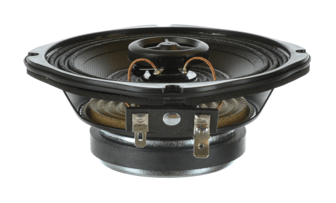The Differences Between a Midrange Speaker and a Full Range Speaker
Editor’s note: This blog from 2022 was updated in 2023 with links to other relevant blogs and product examples.
Most audio designers and even audio consumers tend to focus on the loudspeaker drivers at the extremes: the woofer for its deep bass (less than 100 Hz) and the tweeter for its ability to reproduce the highest tones (above 5 kHz)–even frequencies most of us can’t hear above 15 kHz.
Ironically, the speakers that are the true workhorses of most audio systems, the ones that produce most of the fundamental tones in speech and music, get the least attention: full range and midrange speakers.
What is a Full Range Speaker?
A full range speaker, also referred to as a wide band speaker, is designed to cover several octaves of frequencies, from approximately 150 Hz to sometimes as high as 20 kHz. While there is no specific definition of what makes a speaker full range/wide band, their ability to reproduce 6 or more octaves is a common characteristic.
These speakers may sometimes be the only speakers in an audio system–for example in a Bluetooth or smart speaker with only one driver. Their remarkable ability to produce so much range is achieved by special designs that allow enough cone compliance to produce lower tones but use special materials–lightweight cones and coils–to reproduce the high pitches.
 Full range speakers can be round, square, or oval. They are generally 2” – 8” in diameter and have power capabilities between 1 and 100 watts. If we stretch the definition a bit, we can include a special type of full range speaker, which is really a combination of speaker drivers–essentially two speakers built into one–called a coaxial speaker. Coaxial speakers typically consist of a tweeter built into the middle of a woofer. These speakers have become the backbone of many car audio and background music systems because of their space-saving design.
Full range speakers can be round, square, or oval. They are generally 2” – 8” in diameter and have power capabilities between 1 and 100 watts. If we stretch the definition a bit, we can include a special type of full range speaker, which is really a combination of speaker drivers–essentially two speakers built into one–called a coaxial speaker. Coaxial speakers typically consist of a tweeter built into the middle of a woofer. These speakers have become the backbone of many car audio and background music systems because of their space-saving design.
Resource: Full Range and Wide Range Speakers From MISCO
What is a Midrange Speaker?
We might consider a midrange speaker to be a narrower-band version of the full range speaker and it is designed to reproduce approximately 4 or 5 octaves of sound, between 150 – 3000 Hz. Like the full range/wide band speaker, these are often designed using lightweight moving parts to increase efficiency and sensitivity and tie together the woofer and tweeter in a multi-speaker element design.
Midrange speakers typically have a cone that is between 4” and 6.5” in diameter. A related speaker is a midbass driver which is a variation of a woofer, but with a slightly higher resonant frequency (80 – 100 Hz) and also an upper-frequency range to blend in with the tweeter of an audio system. A subwoofer + midbass + tweeter is the core of many consumer hi-fi audio systems.
By using different materials, designs, and testing, loudspeaker manufacturers can engineer speakers to perform very well at specific frequencies.
Resource: Midrange and Midbass Speakers From MISCO
Finding Your Speaker Sweet Spot
Speakers sound best when they are operating in the sweet spot of frequencies they were designed for. This is when the speaker is operating in predominantly an efficient, pistonic motion, and power is being transformed into sound and not heat. For a woofer, that’s generally below 100 Hz, and for a tweeter that’s often above 3 kHz.
Yet, because many music fundamentals are outside that range (a trumpet plays from 165 Hz to 900 Hz; a clarinet plays from 147 Hz to 1865 Hz), it’s often the design and integration of the full range/wide band driver, that can be most critical to good system audio quality.
Arriving at a good audio solution is often about pairing the right speakers together in a system. For instance, a manufacturer can make recommendations for what subwoofer and midrange speakers will complement each other well. They can then integrate crossovers into your system so the speaker handles the frequencies it’s designed for.
Seek a conversation with a custom speaker manufacturer to discover the best solution for designing these speakers into your audio system.

